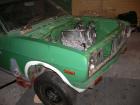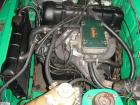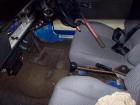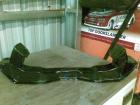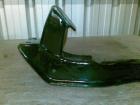The Nissan L-series engine (as in the 1600/510) is a good swap. Inexpensive, readily available both in USA and Australia, and these are a larger engine family than the Nissan A Engine. From L13 to L18, they are nearly identical on the outside. The L20B 2-liter engine is a tall-block variation but can still will fit under the hood and without cutting the sheetmetal. The Z-series Engine is closely related but has a crossflow cylinder head for better all-around torque and fuel economy.
Contents |
Overview
unfamilia: L series should have been standard in the 1200's ... [L16-powered 1200 is] a nice streetable torqey little car.easier to drive than a high rev a series thats for sure.
Discussions
And for L-engine questions unrelated to Datsun 1200s specifically:
Slant
L-series engine has a 12-degree slant to the right.
Deck Height
L20B is 15 mm taller than the L13/L14/L16/L18.
Block deck height (crank centerline to top of block face) 207.85 mm: L13, L14, L16, L18, L24, L28 227.45 mm: L20B, Z20, Z22, L28D
Engines
From L13 to L20B, you have many choices. The larger engines make more power. An L20B makes more power than an L18, similarly outfitted (stock vs stock, or modded vs modded). Rod/stroke ratio don't matter except in theory, because 200 more CCs trumps it. But there seems to be no reason to use an L13 or L14, as the A15 makes about the same power and is lighter and fits easier. So choose an L18 or L20B, depending on availability. Use an L16 if it is handy or free.
DISPLACEMENTS L13 1296cc L14 1428cc L16 1595cc L18 1770cc L20 (1965) 1998cc L23 (1968) 2262cc L20B (1973) 1952cc LD20 1952cc L24 2393cc L26 2565cc L28 2753cc LD28 2792cc
L13: early Datsun 510 Standard models came with L13. Don't bother to swap this, an A14 is better.
L14: Nissan put the L14 in the Japan-only PB110.
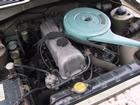

However, why bother these days? Nissan didn't have an A14 in 1970, but we do now, and it is much less work to fit, and weighs a lot less.
L16: A bit more power than an A14/A15 (96 hp vs 80 hp), the L16 is good choice if you obtain one inexpensively.



L18 is a big power boost over an A15 (105 hp vs 80hp)



L20B fitted (92 hp to 110 hp, but with loads of low-RPM hp):
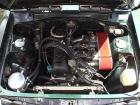




LZ Engine: A super-rare racing engine was the LZ20 twin-cam, fitted to 1200 racing cars.
See main article: [LZ engine]]
LZ20 DOHC engine

L20
There are three 2-liter L-series engines, all very different from each other:
- L20 - Straight six 1966 Cedric engine, 1st L-series engine
- L20A - Straight six based on the L16 (2nd gen design)
- L20B - Inline four cylinder
See http://zhome.com/History/LSeries/LSeriesR1.htm
L20B Sources
Australia Datsun 810 (200B) Datsun/Nissan 910 Bluebird
USA L20B engines came in these models:
- Datsun 620: 1975-1979 model year
- Datsun 720: 1980 only
- Datsun 510: 1978-1979
- Datsun 610: 1974-1976
- Datsun 710: 1975-1977
- Datsun 200SX: 1977-1979 (1977 U67 square port ex. head, 1978-1979 W58 round port ex. head)
USA 1975-1979 Datsun 620 pickup 1977-1979 Datsun 200SX (S10) 1980 Datsun 720 pickup 1975-1976 Datsun 610 1975-1977 Datsun 710 1978-1979 Datsun 510 (A10)
Engine Major Parts
See L-series Engine Components
Crossmember
L-series engine can use the stock B110 L-series crossmember or a A-series crossmember modified.
Or, use the unmodified A-series crossmember with custom engine-side brackets.
See main article: L/Z/KA/SR Crossmember
Engine Sump
L-series and Z-series share the oil pan design:
- 11121-A3500 GASKET-OIL PAN L-series, Z-series
Factory PB110 L-series engine sump is a mid-sump design:
PL620 L16 sump has slightly larger mid-sump than L521. Sump is farther forward, perhaps 1".
L20B-powered 910 Bluebird sump and oil pick up to allow motor to sit as low as possible.
Stanza (A10) and 200B sumps are also front sumps but are slightly larger than the bluebird ones so the engine cant be sat as low
Datsun 1600 and Datsun 180B (610) sump is slightly more rearward Sumps and pickups can be interchanged, but the blocks may need to be drilled for the dipstick.
Vanette winged sump fits unmodified 1200 crossmember.



Plenty of room for adding custom wings to a standard sump too (although it is unnecesary and will require more oil each change):
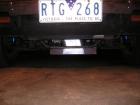
Transmission
63-series transmissiosn for L Engine fit quite snuggly in the standard Datsun 1200 manual tunnel. Transmissions for Z engine and L engine bolt to either engine but the L engine is slanted by about 10 degrees, so it affects the angle the shifter comes out.
-
 engine tilt
engine tilt
- Note the CA Engines have a different bell pattern so their gearboxes do not fit the L Engine.
Using a stubby transmission will line up with the 1200 shifter hole. It is about 5 or 6 inches shorter than the more common L-engine transmissions. These are also called shorty, stumpy, or short-tailed.
- Stubby is ~26.3 inches -- same length as Datsun 510 automatic transmission
4-speed stubby gearboxes are common:
- 1968-1973 Datsun 510 ("1600") F4W63
5-speed stubby gearboxes comes from:
- 1981-1985 R30 Skyline with L24 six-cylinder engine
- 1977-1979 200SX USA S10 (L-series engine, FS5W63 "smoothcase" dogleg)
- 1968-1973 PL510 (L-series engine, F4W63 "bottom pan")
- 720 FS5W71B "ribbed case" used on certain 720 4X4s (long wheelbase?)
- Z-engined series
- may have had an L series in 1980 only
Comparo
- Regular
- ~31.5 inches overall transmission length
- transmission extension housing about same length as (front) transmission case
- From the bottom front of the bell housing to the cross member bolts is ~21-1/2"
- Stubby
- ~26.3 inches overall transmission length
- transmission extension housing about 5" shorter than transmission case
Or use a standard L-engine transmission. The only bit of cutting wil be 1/2 of the gearstick hole but that can be welded that back in the other side to make the factory rubber shifter gasket fit back in. You can see it here:
Photo Gallery: L Engine transmission comparison photos at Ratsun.net
- Reverse lamp switch -- depending on the gearbox model used -- may not fit. See Reverse Lamp Switch#Custom
- Rear crossmember (gearbox xmember) may not line up with transmission mount -- depending on the gearbox model used.
Rear Crossmember
Rear crossmember (Transmission Mount)
Depending on which gearbox you use, the xmember may need a bit of spacing to provide clearance.
L20B Swap Notes
The L20B is a 2-liter four cylinder engine. Not to be confused with the 2-liter six cylinder L20. The L20B is about 19mm taller than other L-series fours.

- no holes cut
- just panel beat the lower corners of the front of the tunnel with a hammer, as the L series is wider
- modify the engine mounts on the crossmember
- 1200 crossmember had the mounts trimmed to an angle simular to that of an 810, then cut the 810 mounts in 1/2 to finish the job and locate the motor lower and improve the mounting angles.
- 810 oil sump is a near-perfect fit in the 1200, reshape it a little just so it will clear the crossmember, maybe 5 mm with a hammer
- Or use 5mm spacers between crossmember and body
- The bonnet will close over sidedraft carburetors (inluding twin Hitachi carburetors)
- The bonnet will close over downdraft carburetor if the engine is low enough. It is a tight fit. Use a low-profile carb insulator/spacer.
- fitting the radiator in isn't a problem. you'll need a thermostat-controlled fan in front of the radiator (i.e. on the grill side)
Swap Notes
Engine Fitment
Engine fitment: It is a tight fit
Method 1: Lower car over engine
Method 2: put engine and transmission in separately. First put in the transmission, then the engine. If the transmission is removed/installed, remove the radiator and slide the engine forward to gain enough room for the gearbox fitting.
Method 3: If you have the larger Auto tunnel, finagle it. With an L16/L18, it only need the lip of the radiator core support bent slightly out of the way.
photo  photo
photo  photo
photo  photo
photo 
Method 4: Cut the radiator core support
Tunnel Clearance
Clearance the 1200 manual tunnel:
Or use the larger 1200 Automatic Tunnel, or B210/610/A10 tunnel.
Oil Filter
Use filter housing from Bluebird or maybe 710, so the filter doesn't interfere with the crossmember.
Or use a remote filter adapter:

Exhaust
Datsun 510 (1600) headers reportedly fit well in a 1200.
Other
When using a 63-series 5-speed, you can use Datsun 1200 Automatic tailshaft.
Use an electric fan, as there usually is not enough room for standard engine-driven fan.
New struts are not required. The L Engine is not that much heavier than a 1200, so you can modify slightly heavier springs to fit the Datsun 1200 struts. Or just let the extra weight lower your 1200 a bit.
If you plan to drive faster, and so want to fit bigger brakes, see Brake Upgrades.
The L-series uses the same Temperature Sender as A-series, so it works with the stock 1200 gauges.
Diff
With the extra torque of an L16, L18 or L20B, you will want to fit a larger diff. Nissan put the H165 into the L14-powered PB110.
An A10 (Stanza/510) auto or manual driveshaft may fit with H165 diff.
Aussie: Fit 120Y sedan Borg Warner diff and automatic tailshaft. The BW68 diff will handle an L-series engine.

![[Datsun 1200 encyclopedia]](/wiki/upload/wiki.png)





